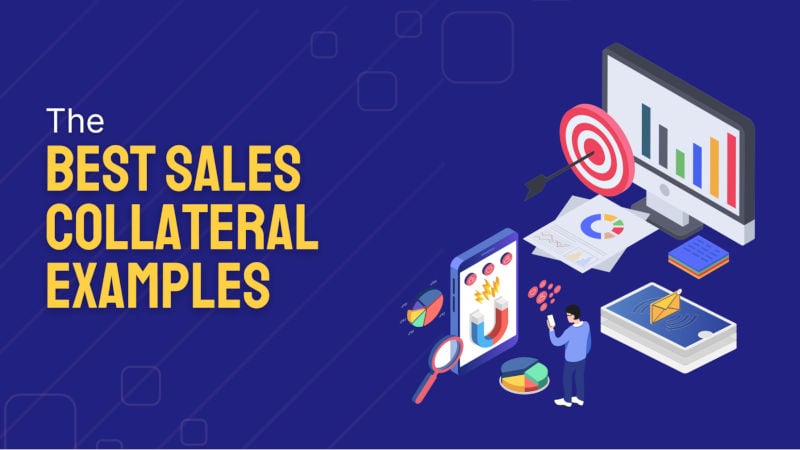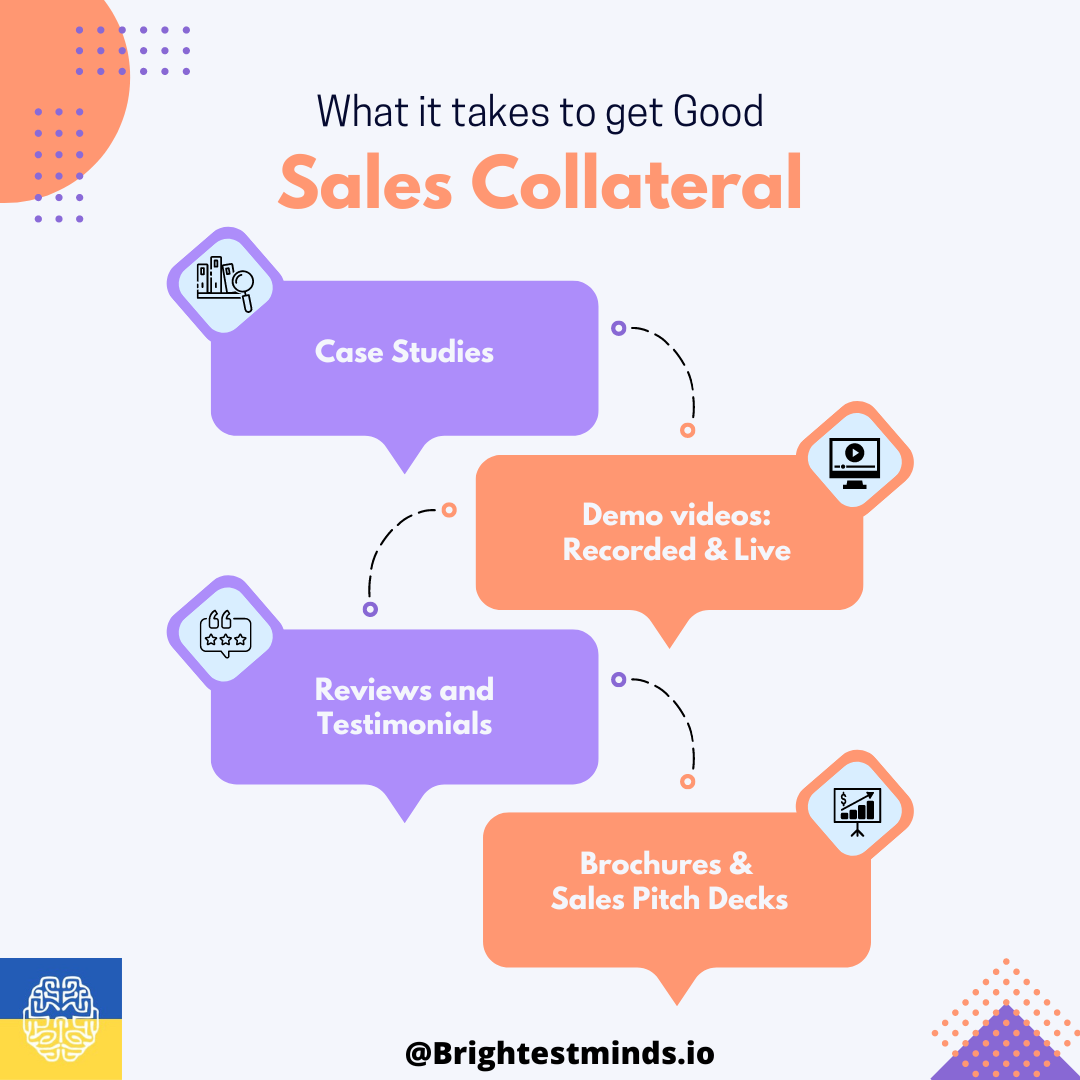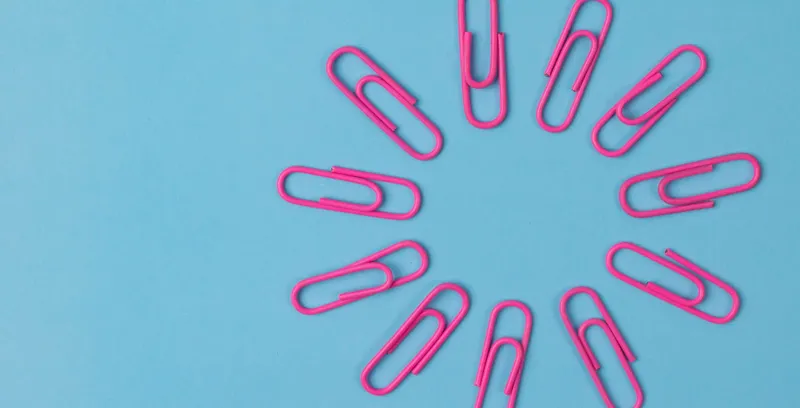Sales collateral can be incredibly effective in helping you close more deals, but creating the right pieces can be challenging.

Table of contents
Without the right sales collateral, you might as well not even bother trying to sell your product or service. If you want to stand out, you need great demos, brochures, and case studies, among others.
For your convenience, we've compiled some of the best sales collateral examples out there to help get you started.
With case studies, the importance of reviews, and testimonials (plus more), this piece has important points to help you create effective sales collateral that will help you generate more leads.
What is sales collateral?
For salespeople to build meaningful relationships, generate leads, and close deals, they need a robust toolkit. If they want to convince buyers the product or service they're selling is worth the money, they need the right information at the right time.
Sales collateral gives you that kind of info! It can be any kind of content (text, visual, or video) that can help sellers propel prospects through the sales funnel and help clients make a purchase.

Here are 5 forms of sales collateral best practices:
1. Product demo videos
Make sure prospects understand what you are selling, especially a high-tech product, which is a huge challenge when selling online. In addition, many people find it frustrating that they cannot touch, feel, or hold the product.
Demonstrating your product or service with the help of an expert or an animation can give your prospects a better understanding of how it works. Feel free to use an animated video maker to make the work easier and faster.
Selling with demos is easier
Currently, 82% of all online traffic is video, with a million videos crossing the internet per second.
A video explaining a product's advantages convinces about 75% of customers to make a purchase (if they can watch it first). Don't let this trend pass you by.
Demos: recorded and live
A recorded demo is a video demonstration that can be accessed at any time by potential customers. By registering on your site (through these demos), they can provide valuable leads for you.
The trend of live demos is on the rise. After registering, users can access these live-streamed events at a particular link. For the first time, organizing live streaming takes quite a bit of effort, but it's worth it.
Choosing the right video engagement platform is key to hosting live demos successfully - while engaging your audience throughout the demo to effectively qualify leads.
Also, this type of sales collateral allows your prospects to ask questions about your product in real time and fill in any gaps in their understanding.
2. Using case studies
Case studies have been used in sales for centuries. A customer who sees you have solved someone else's similar problem will be less likely to doubt your claims.
Case studies can be extremely effective sales collateral. 66% of B2B marketers consider them 'very effective,' and 32% believe them to be 'quite effective.'
Case studies are one type of sales collateral that can be used to showcase your company's successes and help prospects see how you could solve their specific problem.
A well-written case study will include critical information about the customer, the challenge they faced, and how your company was able to help. By providing these details, you can help your prospect understand how you could potentially solve their problem as well.
Including case studies as part of your sales collateral is a great way to build trust with prospects and show that you have a track record of success.
Why should I use case studies in sales collateral?
By featuring case studies prominently on your website or as part of a pitch deck, you can:
- Instill confidence in prospects that you can solve their specific problem
- Help prospects visualize how your product or service works in real-life scenarios
- Show that you've had success with other customers
- Build trust with prospects by sharing customer stories
3. Reviews and testimonials
More than 87% of local customers read online reviews before making a purchase.
It's not surprising that people trust unbiased opinions far more than the information displayed in your website's "About Us" section.
This is why creating a process that encourages customers to write reviews and testimonials is essential.
Reviews online are great but aren't enough. Follow-up surveys can be used to learn the opinions of your previous customers to convert them into sales collateral.
You can do this by:
- Creating a testimonial form that is easy to fill out and doesn't take a lot of time.
- Emailing them next with this subject line – "We value your opinion."
- Establishing a database and selecting testimonials that you believe are worth showing your prospects.
- Making sure you ask permission before using them on your website or in promotional materials – your company's reputation is at stake; it isn't a matter of politeness.
4. Sales pitch deck
Usually, a sales deck consists of colorful slides. Salespeople should (and usually) carry a copy with them at all times. This is to show prospects at parties after business forums, in cabs, or even in elevators!
An employee of a targeted company who is already familiar with your product is more likely to be interested in it during the deal stage when such a presentation is made.
Good/bad sales deck
The best sales deck gives your prospects a complete picture of what you offer in a concise manner.
Salespeople should never forget that potential customers do not care about your products.
Customers care about your product or service's ability to solve their problems.
This type of sales collateral shows how a prospect feels when they have a problem and how they feel after the problem is resolved.
If you want to avoid ruining the whole impression of the product, do not make the following mistakes:
- A sales deck is terrible if it's too much about "you" and not enough about the customers.
- The message is unclear and awkwardly delivered.
- Information overload and too much text.
- Instead of being driven by stories, it is driven by your product.
Shorter is better
Sales decks are not supposed to be long reads, i.e., 20 slides max of well-organized text accompanied by illustrations.
Typically, a prospect spends about ten minutes reading your 20-page presentation. Only 30 seconds a slide! So try to keep your sales deck text to 30 words.
5. Brochures
Brochures, in particular, are an incredibly effective sales tool that can help you close more deals.
A well-designed brochure can be the difference between a prospect saying "maybe" and "yes." They're essential for giving your prospects a clear overview of your product or service and what sets you apart from the competition.
Creating a great brochure doesn't have to be complicated or expensive. But it is important to take the time to do it right.
With a little effort, you can create a powerful sales tool that will help you close more deals and grow your business.
To create effective brochures, follow these tips:
- Keep it simple: With brochures, less is more. Don't stuff a lot of info into one brochure. Stick to the basics and make sure your message is clear and concise.
- Make it visually appealing: A great brochure should be easy on the eyes. Keep your text to a minimum and use high-quality images.
- Highlight your USPs: What makes your product or service different from the competition? Make sure your brochure highlights your unique selling points and why your prospect should choose you.
- Give your prospect a call to action: What do you want your prospect to do after reading your brochure? Use a clear call to action, such as contacting you for more information or scheduling a consultation.
Conclusion
If you're not using any of the sales collateral best practices we've mentioned, it may be time to give them a try. The upside is clear — more deals closed with less effort.
But don't just believe us for it; test out the methods mentioned above and see what works best for you and your team.
Lastly, if you wanna know how to close more deals and generate leads, drop us a line. We love helping companies achieve their revenue goals!
What type of sales collateral do you find most useful in your line of business? Let us know.
Let’s stay in touch!
Subscribe to GetAccept’s monthly newsletter packed with sales trends and tips, product releases, invitations to special events and webinars — and more! Zero spam. Unsubscribe at any time.




